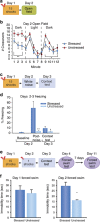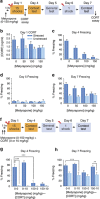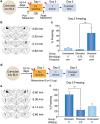Induction and Expression of Fear Sensitization Caused by Acute Traumatic Stress
- PMID: 26329286
- PMCID: PMC4677128
- DOI: 10.1038/npp.2015.224
Induction and Expression of Fear Sensitization Caused by Acute Traumatic Stress
Abstract
Fear promotes adaptive responses to threats. However, when the level of fear is not proportional to the level of threat, maladaptive fear-related behaviors characteristic of anxiety disorders result. Post-traumatic stress disorder develops in response to a traumatic event, and patients often show sensitized reactions to mild stressors associated with the trauma. Stress-enhanced fear learning (SEFL) is a rodent model of this sensitized responding, in which exposure to a 15-shock stressor nonassociatively enhances subsequent fear conditioning training with only a single trial. We examined the role of corticosterone (CORT) in SEFL. Administration of the CORT synthesis blocker metyrapone prior to the stressor, but not at time points after, attenuated SEFL. Moreover, CORT co-administered with metyrapone rescued SEFL. However, CORT alone without the stressor was not sufficient to produce SEFL. In these same animals, we then looked for correlates of SEFL in terms of changes in excitatory receptor expression. Western blot analysis of the basolateral amygdala (BLA) revealed an increase in the GluA1 AMPA receptor subunit that correlated with SEFL. Thus, CORT is permissive to trauma-induced changes in BLA function.
Figures




Similar articles
-
Isoflurane suppresses stress-enhanced fear learning in a rodent model of post-traumatic stress disorder.Anesthesiology. 2009 Mar;110(3):487-95. doi: 10.1097/ALN.0b013e3181974f3e. Anesthesiology. 2009. PMID: 19212264 Free PMC article.
-
Dopamine release and dopamine-related gene expression in the amygdala are modulated by the gastrin-releasing peptide in opposite directions during stress-enhanced fear learning and extinction.Mol Psychiatry. 2025 Jun;30(6):2381-2394. doi: 10.1038/s41380-024-02843-8. Epub 2024 Nov 23. Mol Psychiatry. 2025. PMID: 39580604 Free PMC article.
-
Glutamate receptor expression in the PL-BLA circuit is associated with susceptibility to showing the PTSD-like phenotype.Neurobiol Learn Mem. 2025 May;219:108051. doi: 10.1016/j.nlm.2025.108051. Epub 2025 Mar 27. Neurobiol Learn Mem. 2025. PMID: 40157419
-
Know thy SEFL: Fear sensitization and its relevance to stressor-related disorders.Neurosci Biobehav Rev. 2022 Nov;142:104884. doi: 10.1016/j.neubiorev.2022.104884. Epub 2022 Sep 26. Neurosci Biobehav Rev. 2022. PMID: 36174795 Free PMC article. Review.
-
The potential of epigenetics in stress-enhanced fear learning models of PTSD.Learn Mem. 2016 Sep 15;23(10):576-86. doi: 10.1101/lm.040485.115. Print 2016 Oct. Learn Mem. 2016. PMID: 27634148 Free PMC article. Review.
Cited by
-
Stress reactivity after traumatic brain injury: implications for comorbid post-traumatic stress disorder.Behav Pharmacol. 2019 Apr;30(2 and 3-Spec Issue):115-121. doi: 10.1097/FBP.0000000000000461. Behav Pharmacol. 2019. PMID: 30640181 Free PMC article. Review.
-
Threat-related disorders as persistent motivational states of defense.Curr Opin Behav Sci. 2019 Apr;26:62-68. doi: 10.1016/j.cobeha.2018.10.007. Epub 2018 Oct 25. Curr Opin Behav Sci. 2019. PMID: 31011592 Free PMC article.
-
Environmental certainty influences the neural systems regulating responses to threat and stress.Neurosci Biobehav Rev. 2021 Dec;131:1037-1055. doi: 10.1016/j.neubiorev.2021.10.014. Epub 2021 Oct 18. Neurosci Biobehav Rev. 2021. PMID: 34673111 Free PMC article. Review.
-
Corticotropin-Releasing Factor in the Brain and Blocking Spinal Descending Signals Induce Hyperalgesia in the Latent Sensitization Model of Chronic Pain.Neuroscience. 2018 Jun 15;381:149-158. doi: 10.1016/j.neuroscience.2018.03.024. Neuroscience. 2018. PMID: 29776484 Free PMC article.
-
Behavioral and structural adaptations to stress.Front Neuroendocrinol. 2018 Apr;49:106-113. doi: 10.1016/j.yfrne.2018.02.002. Epub 2018 Feb 5. Front Neuroendocrinol. 2018. PMID: 29421158 Free PMC article. Review.
References
-
- Adamec R, Blundell J, Burton P (2005). Role of NMDA receptors in the lateralized potentiation of amygdala afferent and efferent neural transmission produced by predator stress. Physiol Behav 86: 75–91. - PubMed
-
- American Psychiatric Association (2013) Diagnostic and statistical manual V. American Psychiatric Press: Washington, DC.
-
- Antoni FA (1986). Hypothalamic control of adrenocorticotropin secretion: advances since the discovery of 41-residue corticotropin-releasing Factor. Endocr Rev 7: 351–378. - PubMed
-
- Baker DG, West SA, Nicholson WE, Ekhator NN, Kaschow JW, Hill KK et al (1999). Serial CSF corticotropin-releasing hormone levels and adrenocortical activity in combat veterans with posttraumatic stress disorder. Am J Psychiatry 156: 585–588. - PubMed
-
- Bonne O, Grillon C, Vythilingam M, Neumeister A, Charney DS (2004). Adaptive and maladaptive psychobiological responses to severe psychological stress: implications for the discovery of novel pharmacotherapy. Neurosci Biobehav Rev 28: 65–94. - PubMed
Publication types
MeSH terms
Substances
Grants and funding
LinkOut - more resources
Full Text Sources
Other Literature Sources
Medical

